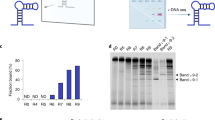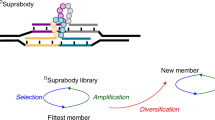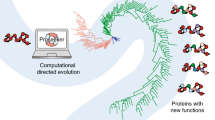Abstract
WE have isolated a set of ligand-binding DNA sequences from a large pool of random sequence DNAs by selection and amplification in vitro, using similar methods to those described for the isolation of ligand-binding RNAs1. The ligand–DNA inter-actions are both sequence- and ligand-specific, and are dependent on proper folding of the single-stranded DNA. Some ligands led to the isolation of more DNA sequences than RNA sequences, and vice versa. Analysis of individual sequences reveals that ligand binding is DNA-specific; RNAs of identical sequence could not interact with the same ligands. Ligand-binding DNAs might be more suitable than RNAs as potential pharmacological reagents2–4 because of the greater stability of DNA. The apparent primacy of RNA in the early evolution of life5–7 may have been due to its availability rather than to its functional superiority.
This is a preview of subscription content, access via your institution
Access options
Subscribe to this journal
Receive 51 print issues and online access
$199.00 per year
only $3.90 per issue
Buy this article
- Purchase on Springer Link
- Instant access to full article PDF
Prices may be subject to local taxes which are calculated during checkout
Similar content being viewed by others
References
Ellington, A. D. & Szostak, J. W. Nature 346, 818–822 (1990).
Tuerk, C. & Gold, L., Science 249, 505–510 (1990).
Abelson, J. Science 249, 488–489 (1990).
Riordan, M. L. & Martin, J. C. Nature 350, 442–443 (1991).
Gilbert, W. Nature 319, 618 (1986).
Visser, C. M. & Kellog, R. M. J. moiec. Evol, 11, 171–187 (1978).
Orgel, L. E. & Sulston, J. E., in Prebiotic and Biochemical Evolution (eds Kimball, A. P. & Oro, J), 89–94 (North-Holland, Amsterdam, 1971).
Gyllenstein, U. B. & Erlich, H. A. Proc. natn. Acad. Sci. U.S.A. 85, 7652–7656 (1988).
Arnold, F. H. Schofield, S. A. & Blanch, H. W. J. Chromatogr, 355, 1–12 (1986).
Schultz, P. G., Lerner, R. A. & Benkovic, S. J. J. chem. Engng News 68, 26–40 (1990).
Ellington, A. D. in Current Protocols in Molecular Biology (eds Ausubel, F. M. et al.) 2.12.1–2.12.5. (Wiley-Interscience, New York, 1987).
Green, R., Ellington, A. D., Bartel, D. P. & Szostak, J. W. Methods 2, 75–86 (1991).
Author information
Authors and Affiliations
Rights and permissions
About this article
Cite this article
Ellington, A., Szostak, J. Selection in vitro of single-stranded DNA molecules that fold into specific ligand-binding structures. Nature 355, 850–852 (1992). https://doi.org/10.1038/355850a0
Received:
Accepted:
Issue Date:
DOI: https://doi.org/10.1038/355850a0
This article is cited by
-
Biosensor for ATP detection via aptamer-modified PDA@POSS nanoparticles synthesized in a microfluidic reactor
Microchimica Acta (2024)
-
Genome-wide identification of Kanamycin B binding RNA in Escherichia coli
BMC Genomics (2023)
-
Generation of DNA oligomers with similar chemical kinetics via in-silico optimization
Communications Chemistry (2023)
-
Diverse applications and development of aptamer detection technology
Analytical Sciences (2023)
-
Quantitative Methods for Metabolite Analysis in Metabolic Engineering
Biotechnology and Bioprocess Engineering (2023)
Comments
By submitting a comment you agree to abide by our Terms and Community Guidelines. If you find something abusive or that does not comply with our terms or guidelines please flag it as inappropriate.



